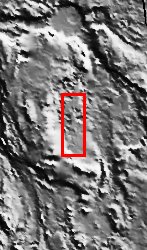
Released 2 December 2003
Just across Ares Vallis from Aram Chaos lies a heavily eroded crater filled by material that is on its way out. This two-frame mosaic of THEMIS VIS images shows the floor of a crater that was filled by material of unknown origin. That material is now being eroded in a manner that is quite enigmatic. Note that the irregular depressions have varying depths across the scene. It appears that the crater fill material begins to erode through the formation of depressions that then deepen over time. Why the depressions form in the first place is a mystery.
Image information: VIS instrument. Latitude 2.4, Longitude 343.6 East (16.4 West). 19 meter/pixel resolution.
Note: this THEMIS visual image has not been radiometrically nor geometrically calibrated for this preliminary release. An empirical correction has been performed to remove instrumental effects. A linear shift has been applied in the cross-track and down-track direction to approximate spacecraft and planetary motion. Fully calibrated and geometrically projected images will be released through the Planetary Data System in accordance with Project policies at a later time.
NASA's Jet Propulsion Laboratory manages the 2001 Mars Odyssey mission for NASA's Office of Space Science, Washington, D.C. The Thermal Emission Imaging System (THEMIS) was developed by Arizona State University, Tempe, in collaboration with Raytheon Santa Barbara Remote Sensing. The THEMIS investigation is led by Dr. Philip Christensen at Arizona State University. Lockheed Martin Astronautics, Denver, is the prime contractor for the Odyssey project, and developed and built the orbiter. Mission operations are conducted jointly from Lockheed Martin and from JPL, a division of the California Institute of Technology in Pasadena.

